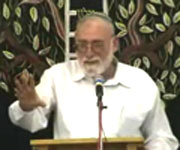Beit Midrash
- Torah Portion and Tanach
- Shmot
- Yitro
Students of the Kabbalah will speak of the 'seven spheres', representing the seven concentric points of spiritual elevation in drawing oneself closer to G-d. These include: Chesed, Gevurah, Tiferet, Netzach, Hod, Yesod, and Malchut. However, there are, to be sure, three additional rungs on this ladder of spiritual ascent known as: Chochmah, Binah, and Da'at (acronym: 'Chabad'). All told, the nearly impossible task of achieving full rendezvous with G-d ('Deveikut' in Chassidic literature) demands movement through ten unique dimensions of spiritual existence. The number '10' represents totality and absolute perfection. Only G-d, the One and Only, could possibly fit this description. Hence, the human struggle to engage in such an encounter with G-d requires setting the number '10' as his goal.
R' Sa'adiah Gaon is credited as saying that the 'Ten Commandments' are to be understood as headlines for the entire listing of the 613 Biblical commandments. Moshe, at Mt. Sinai, received in a compact format the entire Torah. Our Sages (Berachot 5a) offer a tradition that the 'Ten Commandments' contain within them the entire spectrum of Torah including the entire Bible, the Mishnah, and the Talmud! The revelation of G-d's Torah to His people would necessarily be total, complete, and perfect. It is no accident that the numerical value attached to this act of revelation would be the number '10'. Of course, to G-d, nothing could be considered divisible. This is the basis of Rashi's comment in Parshat Yitro (Shemot 20:1) that all of the 'Ten Commandment' was given as one 'utterance' ("b'dibur echad"). Our great teacher, HaRav Yosef Dov Soloveitchik Zt"l, once pointed out that in referring to the first set of the tablets, the Torah uses the singular form to describe the stone of the tablets (Shemot 31:18, "luchot even"). While, on the other hand, the reference to the second set of the tablets, we find the description of the stone to be in the plural form (Devarim 9:10,"luchot avanim"). Unity would permeate the Divine-made tablets as opposed to the segmented man-made second version.
The number '10' shows up once again in the internal design of the Musaf for Rosh HaShana. Each section of the three central ingredients 'Malchi'yot', 'Zichronot', and 'Shofarot' carries with it the requisite ten Biblical citations (three from the Torah; three from Tehillim; three from the Neve'im; and a final quote from the Torah). There are actually ten items on that particular Musaf prayer agenda. However, an oral tradition has it that we get it all in by reciting only nine blessings and not the full ten. (As a matter of fact, a three-way dispute amongst the Sages exists as to how one goes about organizing ten items into nine structured blessings!) Again, HaRav Soloveitchik explained that regarding that which G-d teaches (i.e. the Biblical citations), one certainly can use the number '10'. However, when mortal man speaks to G-d in prayer, he can only strive to attain '10', but must ultimately recognize the futility in its absolute achievement. Therefore, in prayer, we will only use a nine blessing framework in spite of the ten items on our prayer agenda. (This, incidentally, also serves as the rationale behind the insistence of the Vilna Gaon that the final (i.e. the tenth) expression of praise of G-d uttered by man in the saying of Kaddish "V'yit'halal" should be deleted!).
A most famous teaching of the Zohar spells out an equation linking G-d, His Torah, and the His nation the Jewish people. We have seen that the number '10', representing totality and perfection, is associated with G-d himself. By extension, the number '10' can be applied to the Torah as well, being the revealed Will of G-d Himself. Hence, we have the 'Ten Commandments'. It, therefore, should come as no surprise that the Halachic quorum necessary to form a 'Minyan' would be the same number '10'. A 'Minyan' for purposes of public prayer is not to be understood as a gathering of ten individuals. A 'Minyan' is a representative body of the entire nation of Israel, covering the past, the present, as well as the future. The Talmud (Megillah 23b) derives the number '10' for 'Minyan' purposes from the ten wicked spies episode, connecting those verses with Vayikra 22:32 "And I will be sanctified amongst the Children of Israel". All of the Halachic examples requiring a 'Minyan' are acts of 'Kiddush Hashem' performed, in a sense, in the presence and in the midst - of the eternal Klall Yisrael. The numerical value assigned to designate the group of individuals now representing the entire Jewish people is borrowed from G-d Himself. Hence, the 'Minyan' consists of the number '10'.
Rambam teaches us (Mishnah Commentary, Bechorot 4:3) that the very definition of the community of Israel ("Kahal") relates only to those Jews who inhabit Eretz Yisrael. In his Book of Commandments (Positive commandment #153), Rambam goes so far as to give the precise minimum number to the "Kahal" status of the Jewish people in the Land. He speaks of at least ten such residents! Bearing in mind that the division of Eretz Yisrael did not include two of the tribes (Reu'ven and Gad opted out), one must recognize that the occupants of that part of Eretz Yisrael endowed with that special virtue of being the "land flowing with milk and honey" would number exactly ten tribes! This, too, was apparently not an accident.
The triangular slogan of Religious Zionism, (as coined by Rav Ze'ev Gold Zt"l): "Eretz Yisrael, L'Am Yisrael, al pi Torat Yisrael", revolves around the number '10' on all levels. Each component, nurtured by the Divine Himself, contributes to the cohesive whole as dictated by the Giver of the 'Ten Commandments.























